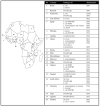Microbial Safety of Milk Production and Fermented Dairy Products in Africa
- PMID: 32429521
- PMCID: PMC7285323
- DOI: 10.3390/microorganisms8050752
Microbial Safety of Milk Production and Fermented Dairy Products in Africa
Abstract
In Africa, milk production, processing and consumption are integral part of traditional food supply, with dairy products being a staple component of recommended healthy diets. This review provides an overview of the microbial safety characteristics of milk production and fermented dairy products in Africa. The object is to highlight the main microbial food safety hazards in the dairy chain and to propose appropriate preventive and control measures. Pathogens of public health concern including Mycobacterium bovis, Brucella abortus and Coxiella burnettii, which have largely been eradicated in many developed nations, still persist in the dairy chain in Africa. Factors such as the natural antimicrobial systems in milk and traditional processing technologies, including fermentation, heating and use of antimicrobial additives, that can potentially contribute to microbial safety of milk and dairy products in Africa will be discussed. Practical approaches to controlling safety hazards in the dairy chain in Africa have been proposed. Governmental regulatory bodies need to set the necessary national and regional safety standards, perform inspections and put measures in place to ensure that the standards are met, including strong enforcement programs within smallholder dairy chains. Dairy chain actors would require upgraded knowledge and training in preventive approaches such as good agricultural practices (GAP), hazard analysis and critical control points (HACCP) design and implementation and good hygienic practices (GHPs). Food safety education programs should be incorporated into school curricula, beginning at the basic school levels, to improve food safety cognition among students and promote life-long safe food handling behaviour.
Keywords: HACCP; dairy; fermentation; microbial hazards; pasteurization; pathogens; raw milk.
Conflict of interest statement
The authors declare no conflict of interest.
Figures


References
-
- Dirar H.A. The Indigenous Fermented Foods of the Sudan: A Study in African Food and Nutrition. CAB International; Wallingford, UK: 1993.
-
- Fratkin E. Pastoralism and Development in Africa: Dynamic Change at the Margins New York. Routledge; Abingdon, UK: 2013. Seeking alternative livelihoods in pastoral areas.
-
- Wurzinger M., Okeyo A.M., Semambo D., Souml J. The sedentarisation process of the Bahima in Uganda: An emic view. Afric. J. Agric. Res. 2009;4:1154–1158.
-
- Wuehler S.E., Hess S.Y., Brown K.H. Accelerating improvements in nutritional and health status of young children in the Sahel region of Sub-Saharan Africa: Review of international guidelines on infant and young child feeding and nutrition. Matern. Child. Nutr. 2011;7:6–34. doi: 10.1111/j.1740-8709.2010.00306.x. - DOI - PMC - PubMed
Publication types
LinkOut - more resources
Full Text Sources
Molecular Biology Databases
Miscellaneous

